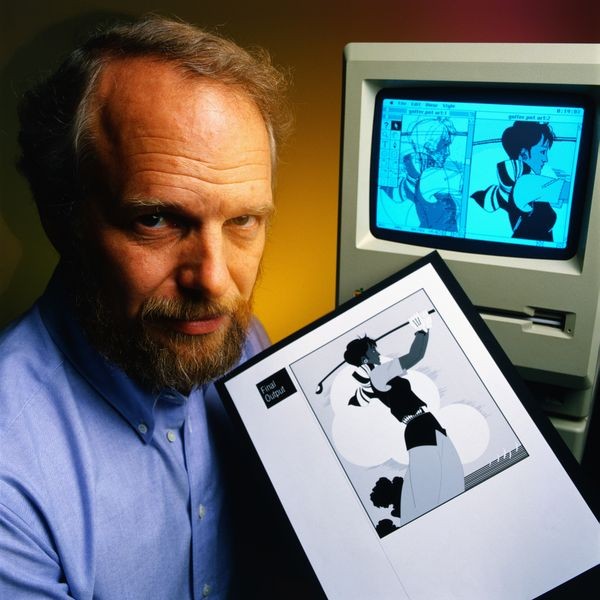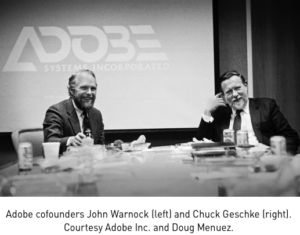On August 19, 2023 John Warnock, co-founder of Adobe died at age 82 of pancreatic cancer. Sadly and somewhat ironically, this is the same kind of cancer that robbed the world of Steve Jobs, Warnock’s fellow technology visionary, at the age of 56 in 2011.
The careers and accomplishments of these two men wove themselves in and out for decades from the early 1980s until Jobs’ death. The story of Jobs and Apple is legendary. The story of Warnock (and company co-founder Chuck Geschke) and Adobe is less known, but arguably much, much more revolutionary.
It was on January 22, 1984, during that year’s Super Bowl, the now-iconic and totally unforgettable Apple Computer advertisement aired. The commercial never showed the computer itself, but ended with this audio: “On January 24th, Apple Computer will introduce Macintosh. And you’ll see why 1984 won’t be like ‘1984.’”
It has long been my opinion the real reason 1984 was not like the book 1984 and one of the foundational reasons the entire world began to change so profoundly that year is because of the software that is PostScript and not hardware that was Macintosh. As a technology researcher, writer, and editor at National Software Testing Laboratories at the time, I watched the history of the software and the hardware unfold in real time, an experience which has never left me.
To be sure, in 1984, the Macintosh was new and exciting. It got a lot of press in the tech world, but also captured the imagination of the world press. Having Jobs, a young, handsome, and charismatic wunderkind, as its pitchman helped.
Postscript, which Warnock and Geschke introduced in the same year, on the other hand, was, to most people, completely unknown. Even in the graphic arts community at the time, its birth was overlooked, and its potential unrecognized.
But, Jobs needed Postscript to fuel a printer to go with the Macintosh: his LaserWriter. Without the LaserWriter and its Postscript-based print controller, the Macintosh could not have survived more than a few years after its birth.

As cute as it was, the Mac was surrounded in the computer marketplace by some tough, older competition. As someone remarked to me at the time, nobody ever got fired for buying IBM.
The LaserWriter, which premiered in 1985, was a game-changer for Apple and Adobe. For the rest of us, it was a world-changer. For the first time, thanks to the computer language living inside the printer, which some have called a “software printing press,” publishing could be done on the desktop. Ordinary people could plan, design, and print whatever they wanted.
And with that, desktop publishing was born, and it started its own revolution. As John Seybold, one of the founders of the Seybold Report newsletter (which I joined as an editor in 1988 and now own) dubbed it: WYSIWYG (“What You See Is What You Get”).
PostScript also made two more things possible that were also needed to make Apple and its Macintosh champions: device independence and digital fonts. Warnock and Geschke found a way to surmount both of these challenges as well.
A simple blog post does not permit further description of these particulars, but perhaps a quotation from John Warnock, part of a 2017 Computer History Museum oral history, will suffice, “We showed those to Jonathan Seybold, and he couldn’t believe his eyes. He said, “Really?” He said, “This—you have solved the problem,” okay, “For laser printers,” and then Seybold added, “This is revolutionary. This is going to change the world.” Jonathan Seybold is one of John Seybold’s children and founder of the now-defunct Seybold Seminars.
In December 2022 the Computer History Museum released a copy of PostScript source code dated late 1984 as part of its Art of Code Series. Warnock was enthusiastic about the release; he believed in innovation, and he knew the value of history.
David C. Brock, director of curatorial affairs at the Computer History Museum, said at the time of the release, “The story of PostScript has many different facets. It is a story about profound changes in human literacy as well as a story of trade secrets within source code. It is a story about the importance of teams, and of geometry. And it is a story of the motivations and educations of engineer-entrepreneurs.”
Desktop publishing lives on today in the form of digital publishing, and Postscript lives on, too. Millions of people around the world use PostScript on a daily basis and do not know it: the ubiquitous Portable Document Format (PDF), which Adobe introduced in 1993, is based on PostScript. The software is also still used in multiple types of imaging devices around the world.
By Molly Joss
September 2023


